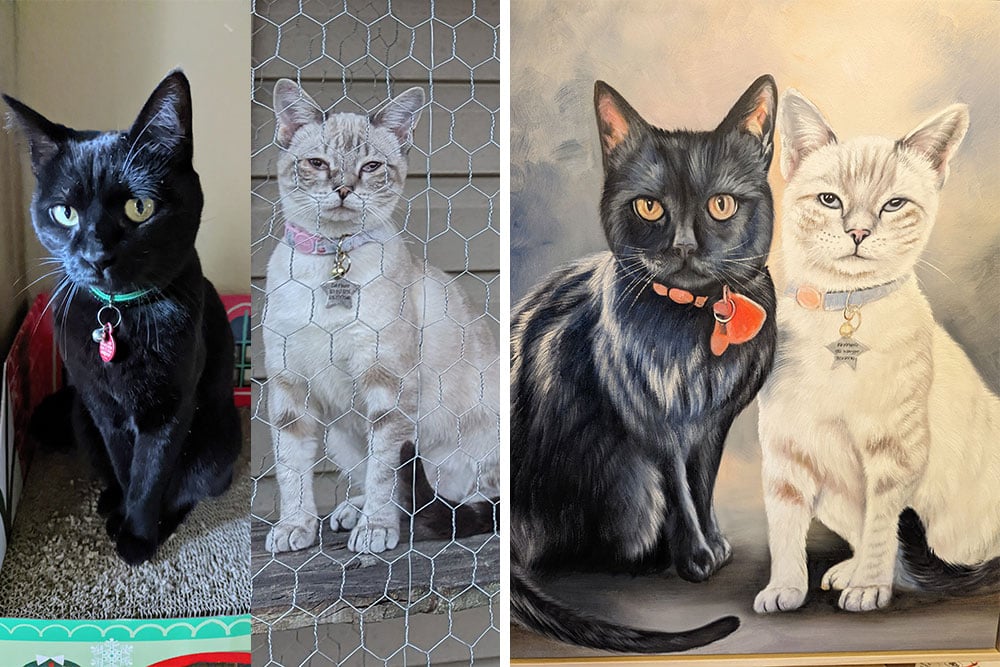We give Paint Your Life a rating of 4.5 out of 5 stars.
What Is Paint Your Life? How Does It Work?
Have you ever seen a beautiful piece of original, custom art in someone’s house and thought that you’d never be able to afford something like that? Well, Paint Your Life aims to make hand-painted portraits a reality for more people by offering a wide range of prices and options. They offer fully customizable options, from portrait size to framing to medium.
You’ll submit your picture or pictures, and they can either make an exact replica of the photo you submit, or they can create a new and original piece of art from reference photos. Obviously, we’re here to talk about pet portraits, but Paint Your Life also offers portraits of people, people with animals, landscapes, and buildings. While you may not receive a Van Gogh from Paint Your Life, you can feel confident that you will receive a high-quality portrait of your favorite friends.
They will work with you to ensure you get the portrait you’ve been dreaming of because nobody wants to end up with a pricey portrait they don’t like. Everything is done through the Paint Your Life website, which offers a user-friendly experience.

Paint Your Life – A Quick Look
- Multiple pricing options
- Multiple options for size, framing, medium, and portrait design
- User-friendly website
- High-quality portraits
- 100% satisfaction guarantee
- Larger portraits may be out of some budgets
Paint Your Life Pricing
The pricing offered by Paint Your Life starts at $149 for the smallest size portrait, which is an 8” x 10”. This portrait can only contain a single subject due to its size. For reference, this is a little bit smaller than an average sheet of printer paper.
Pricing changes as you add on the options offered by Paint Your Life. Additional subjects incur an additional charge, as do larger portrait sizes, specialty frames, and original pictures created from reference photos. You can choose to use the video service, which costs $99 and provides you with a video of your portrait being created. You can also add an artist’s signature for a small fee.
The cost of your order is made clear throughout the selection process, so there are no surprises at checkout. Currently, Paint Your Life allows a small deposit at the time of ordering, and they do offer payment plans.
What to Expect From Paint Your Life
Once the portrait has been approved, Paint Your Life is quick to get the portrait created and shipped. Shipping only takes a few days, so you’ll get your portrait quickly once approved, usually within 1–2 weeks. If your portrait is rolled, it will arrive in an art tube. If you have your portrait framed, it will arrive at your house in a cardboard box perfectly sized for the size of your portrait.
It is carefully wrapped in plastic and padding to protect the portrait during shipping. If framed, your portrait will arrive with picture wire attached, so you’ll have it on the wall in no time.
Paint Your Life Options

| Medium: | Oil, charcoal, acrylic, colored pencil, pastel, black pencil |
| Size: | 8” x 10”, 11” x 14”, 12” x 16”, 16” x 20”, 20” x 24”, 24” x 30”, 24” x 36”, 30” x 40”, 36” x 48”, custom |
| Framing: | Rolled (no frame), 1.5” gallery-wrap, 1.06” black textured wrap, 2-1/8” silver legacy rustic, 1” revival brown, 1.5” charcoal, 2.125” satin gold scoop, and more |
| Pricing: | $149+ |
| Special Options: | Video service, artist signature, background, artist selection |
Quality
Your portrait from Paint Your Life will be a unique, hand-made piece of art. The artists employed by Paint Your Life are talented and able to create portraits that are true to their subjects. After you submit your reference photos, you will receive a digital mock-up for approval. The mock-up is intended to give you an idea of what the final product will look like.
Paint Your Life’s artists hand-paint your portrait based on the digital proof that you approve. Therefore, you can expect additional detail and artistic choices that enhance the appearance of the final product in the actual execution of the portrait creation.
Website
The Paint Your Life website is very user-friendly. It walks you through the portrait option selection process in a step-by-step format, making pricing clear along the way. The selection process is organized and easy to understand. There are pictures that accompany most of the options to give you an idea of what you’re ordering.
Examples of what each medium and frame will look like are provided, and there is an option to watch a video to see what the video of your painting being created will look like.

Communication and Customer Service
Customer service is available every step of the way in the Paint Your Life process. They are available through the website and email. You will receive emails letting you know when your portrait proofs are ready to be reviewed, and they will send reminders if they haven’t received your response.
They are friendly and helpful when making modifications to the initial portrait design. Keep in mind that once you accept the portrait proof, you won’t be able to make any more changes.
What if I Don’t Like My Portrait?
If Paint Your Life can’t create proof that you’re happy with, they will offer you a refund. They do have a 100% satisfaction guarantee. Modifications are free as many times as they need to be made to make you happy.
Paint Your Life offers a 100% satisfaction guarantee that allows you to return your portrait for a 100% refund within 30 days of receipt if you aren’t happy with the way it turned out.

Is Paint Your Life a Good Value?
If you’re interested in custom art of pets, people, or places that are meaningful to you, then Paint Your Life is a great value. Their prices are lower than many other custom portrait options, although the larger sizes are still quite pricey.
This is a great way to receive custom artwork for your home without spending thousands of dollars. They also offer discounts if you order multiple portraits, making the value of their products even higher.
FAQ
What Happens if My Art Arrives Damaged?
Paint Your Life will repair the damage for free. If the portrait can’t be repaired, then they will replace it with a newly painted replica of the original piece. If only the frame is damaged, they will either reimburse you for the price of the frame or replace it.
What Happens if My Art Gets Lost in Transit?
Paint Your Life will ship you a brand-new portrait if yours becomes lost in transit, at no cost to you, of course.
How Can I Get My Portrait Sooner for a Special Occasion?
Paint Your Life offers an express service, which moves your order to the front of the line. There is a 15% charge added for this option.
How Long Does It Take for Modifications to Be Made to My Portrait?
Modifications are typically made within 24 hours but can sometimes take up to 3 days.
Does Paint Your Life Ship Outside the US?
Yes, they ship anywhere in the world, but shipping fees will vary.

Our Experience with Paint Your Life
I received an oil painting from Paint Your Life of my two cats, Noodles and Nutmeg. Noodles is a solid black cat, while Nutmeg is a lynx point. While they get along, they don’t cuddle or sit together, so I had to send two separate pictures to Paint Your Life with the hopes that they could combine them in a usable way.
The photos I sent were challenging to combine (different angles and sizes), so I worked with the Paint Your Life artists to make a few modifications. For example, the initial proof and first few modifications had the cats very far apart from each other, so we modified it to have them closer. There was also a size difference between the two cats initially, but that was also corrected through modifications. To help the artists create the best portrait of each cat, I also sent additional reference photos.
Paint Your Life’s artists work closely with the photos you send, so I would recommend sending high-quality photos that show your pets the way you want them. Once I was satisfied with the digital proof, I accepted it and the artists got to work on the painting.
In the end, I received a nice painting of my cats. Although the cats were pictured separately and combined into one setting (as they are not often affectionate with one another), it’s a nice likeness and a high-quality portrait of them both. The quality of the painting itself is nice, and the frame is extremely sturdy. Shipping was fast and the portrait was well protected by the shipping materials.
Conclusion
If you’re looking for a professional quality portrait of your cat without breaking the bank to get it, then Paint Your Life is a good option. They allow you multiple opportunities to customize your portrait to suit your preferences, and they offer a wide range of prices to fit most budgets. This is art and is an investment, so you should still plan to spend around $200 or more for your portrait, especially if you want a portrait with more than one subject in it.
Contents
- What Is Paint Your Life? How Does It Work?
- Paint Your Life – A Quick Look
- Paint Your Life Pricing
- What to Expect From Paint Your Life
- What if I Don’t Like My Portrait?
- Is Paint Your Life a Good Value?
- FAQ
- What Happens if My Art Arrives Damaged?
- What Happens if My Art Gets Lost in Transit?
- How Can I Get My Portrait Sooner for a Special Occasion?
- How Long Does It Take for Modifications to Be Made to My Portrait?
- Does Paint Your Life Ship Outside the US?
- Our Experience with Paint Your Life
- Conclusion












